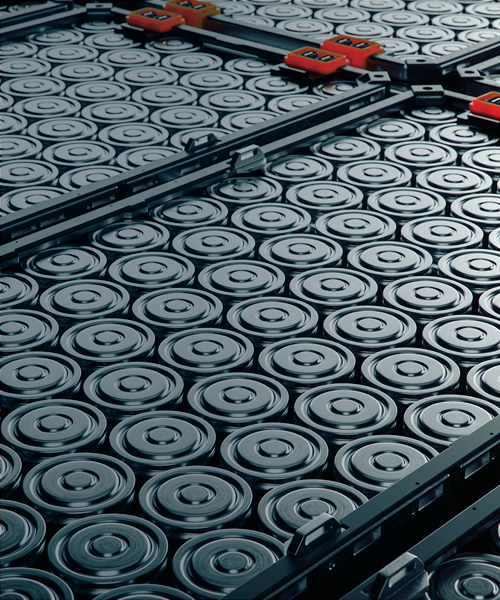August 10, 2023 • 4 min read
Battery materials: solving the challenges of the electromobility revolution
Battery material producers are positioned to capitalize on the growing demand for electric vehicles. But could the looming shortage of energy conversion materials restrict their growth?
The future of the automotive industry depends on gigafactories. These giant battery plants will produce hundreds of thousands of battery packs that auto manufacturers need for their electric vehicles (EV).
“Gigafactories are capital intensive, but car manufacturers and cell manufacturers are investing billions of dollars into them,” says Dave Oudenijeweme, Senior Director, Battery Materials – Growth.
“The challenge is, these gigafactories require a lot of raw materials to make batteries on a large scale. And the projected shortage of key materials in batteries, such as lithium, nickel and graphite, as well as electrical steel and rare earths for magnets, is a direct threat to EV production targets.”
What steps can battery market participants take to guarantee future supply?
The raw material shortage in mining
Battery packs are either produced by dedicated battery manufacturers or produced in-house by car manufacturers. Typically, OEMs are less familiar with mining or the upstream supply chain and rely on their tier one suppliers, the cell manufacturers.
“The world needs hundreds of new mines in operation by 2035 to produce the gigatons of energy conversion materials to meet electrification goals,” says Oudenijeweme. “Several factors are preventing this growth. The most notable is that it currently takes decades to develop a new mine, in addition to a lengthy permitting process beforehand.”
According to Oudenijeweme, part of the problem lies with the world’s miners underinvesting in new mines, which is in part due to the impact of ESG challenges.
“In regions such as Chile and Bolivia, which are rich in lithium reserves, exploration activities are being delayed due to public unrest over environmental issues,” he says. “As a result, the world’s top 10 mining companies only invested around US$20bn in mining projects in 2023. This is half of the US$40bn in 2016.”
Localizing the batteries supply chain
Oudenijeweme notes that the batteries supply chain has historically relied on supply from all over the world, including China.
“Chinese companies have successfully ensured raw material supply through long term offtake agreements and strategic investments,” he says. “One example is Ganfeng Lithium, which through a strategic acquisition, is now one of the largest lithium miners and refiners in the world. Recently it invested US$3.1bn to expand its capacity across three lithium battery plants, becoming fully vertically integrated.”
The reliance on a concentrated supply chain is not the issue, nor is the level of investment required. However, governments across the world with significant end markets and industries to protect want to capitalize on this opportunity.
North America and Europe are looking to stimulate local industry growth. Their actions range from research and development support and capital grant incentives to the influential Inflation Reduction Act.
On the other end of the value chain, countries such as Indonesia, Australia, Canada, and Chile, which have significant resources of nickel, lithium, copper, and other valuable raw materials, are keen to benefit from the EV revolution.
Reducing raw material demand while increasing supply
To reduce the supply chain’s reliance on scarce materials, car and battery manufacturers are finding ways to redesign batteries, such as the development of cobalt-free lithium-ion battery technology.
“In its automotive industry demand forecast, the Advanced Propulsion Centre in the UK concluded increasing supply and reducing demand is the only way to bridge the gap,” says Oudenijeweme. “This means that all plausible lithium mines will need to come online as expected, in tandem with decreasing lithium usage in manufacturing.
“Reducing lithium demand is possible by reducing battery size and greater use of plug-in hybrid with internal combustion, or fuel cell in larger car segments. But this goes against the trend of bigger, heavier cars with longer ranges. And it’s only acceptable to customers if EV charging infrastructure improves quickly.
“We know EV demand is going to grow,” continues Oudenijeweme. “But if automakers don’t have a particular component for the car, they can’t build the car. That’s why winners in this space will have an integrated supply chain and research and development strategy.”
Strategies for success for battery cell manufacturers
In the evolving world of critical minerals, many things remain uncertain. But the overall endpoint is clear: most cars will be powered by electric motors and store energy in a sizeable battery. And cell manufacturing companies realize that securing materials is vital.
“For participants in the battery market, the success of this transition depends on having a vision, strategy, and plan,” says Oudenijeweme. “This requires clear advice at the front end, underpinned by market insights to make the right investment decisions at the right time.
“The growth rate of any battery materials company depends on access to raw materials such as lithium, nickel and copper. This includes vertical integration strategies to better secure supply chains, ranging from taking minor stakes in mining companies to joint ventures. Or it could involve full vertical integration, such as owning a natural graphite extraction operation in Africa that’s directly linked to an active anode plant in the USA.
“What matters most, is addressing supply constraints before they grind assembly lines to a halt,” says Oudenijeweme. “The energy transition depends on it.”
Download the paper
To find out more about the opportunities and challenges for battery material producers, download the whitepaper.





